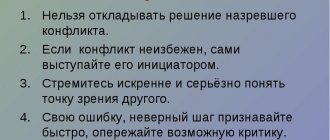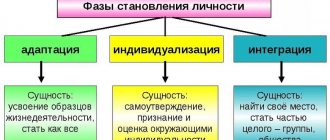Who should resolve a work conflict?
In this matter, much depends on the specifics of the organization and the structure of the team. In many cases, conflict situations are resolved by its participants. Moreover, any party can initiate reconciliation.
In large companies, which employ a large number of employees and there are several structural divisions, conflict resolution is handled by the HR manager or HR manager. Also, this responsibility can be assigned to a representative of the personnel department, but recently this option is rarely practiced. This is explained by the fact that resolving conflict situations is not the direct responsibility of personnel officers.
In small companies, the manager or immediate supervisor of the enterprise can resolve disagreements. At the same time, he is obliged to operate with the current norms of labor legislation.
Links[edit]
- Jump up
↑ Katz, D., & Kahn, R. L. (1978). Social psychology of organizations 2 units. New York: John Wiley. - Gerber, Linda M.; Macionis, John J. (2010). Sociology
(7th Canadian ed.). Pearson Canada. p. 129. ISBN 978-0-13-800270-1. - ^ ab Peters, Joan K. "When Mothers Work: Loving Our Children Without Sacrificing Ourselves". New York Times
. ISBN 0-201-12794-6. - Kahn, R.L.; Wolfe DM; Quinn RP; Snoek JD; Rosenthal R.A. (2010). "Organizational Stress: Studies of Role Conflict and Ambiguity." APA PsycNET
. - Truett, C. (1979). Women in education management: is there a conflict in the main roles? Speeches Documents for meetings, 1–2.
- ^ ab Macionis, John J. (2006). Society: Fundamentals (8th ed.). Upper Saddle River, NJ: Pearson Prentice Hall. ISBN 0-13-192244-0.
- Hines, K.M.; Liu, S. (2012). “Are difficulties in balancing work and family associated with subsequent fertility?” . Educational Resources Clearinghouse
. Retrieved March 20, 2012. - ^a b Dell'Antonia, KJ (1 March 2012). "Motherlode: Adventures in Parenting". New York Times
. Retrieved March 20, 2012. - https://pantherfile.uwm.edu/margo/public/984/Fall2009/articles/HomelessDuncan.pdf [ dead link
] - Hepburn, Jr.; Albonetti, C. (1980). "Role Conflict in Corrections: An Empirical Study of the Treatment-Custody Dilemma Among Correctional Officers" (PDF). Criminology
.
17
(4): 445–460. DOI: 10.1111/j.1745-9125.1980.tb01308.x. CS1 maint: uses the authors parameter (link) - Karp, David R. (2010). "Unmasking Men, Unmasking Masculinity: Doing Men's Work in Prison" (PDF). Journal of Men's Studies
.
18
(1):63–83. Archived from the original (PDF) on March 04, 2016. Retrieved April 26, 2012. - Kemery, Bedeian, Mossholder & Touliatos, 1985
- Mark Dombeck, Ph.D. (July 24, 2007) [https://www.mentalhelp.net/articles/the-long-term-effects-of-bullying/ Long-Term Effects of Bullying] Retrieved June 6, 2016.
- ^ ab McKee, B. A. (1977). Application of role conflict theory to the role expectations placed on dean of students by various reference groups (Doctoral dissertation). University of Florida.. Available from the George A. Smathers Libraries of the University of Florida (applicationofrol00mack).
- Mertensmeyer, C, & Coleman, M. (1987). “Correlates of interrole conflict in young rural and urban parents.” Family Relations
(4th ed.).
Minneapolis: National Council on Family Relations. 36
: 425–429. DOI: 10.2307/584495. JSTOR 584495. CS1 maint: uses the authors parameter (link) - John Macionis, Gerber, John, Linda (2010). Sociology 7th Canadian ed. Toronto, Ontario: Pearson Canada Inc., p. 129.
- ^ a b Hall, D. T. (1972). “Model of coping with role conflict: role behavior of women with higher education.” Administrative Science Quarterly
.
17
(04): 471–486. DOI: 10.2307/2393827. JSTOR 2393827. (subscription required)
LIST OF SOURCES USED
- Ashirov D.A. Organizational behavior: - M.: Prospekt, 2006. - 360c [3]
- Ashirov D.A. Personnel Management. - M.: Prospekt, 2007. - 432 p. [eleven]
- Bukhalkov M.I., Personnel management at the enterprise. – M.: Exam, 2005. – 320 p. [6]
- Vershigora E.E. Management. – M.: INFRA-M, 2003. – 364 p. [15]
- Vesnin V.R. Management. – M.: Prospekt, 2007. – 512 p. [9]
- Galenko V.P., Rakhmanov A.I., Strakhova O.A., Management. – St. Petersburg: Peter, 2003. – 229 p. [4]
- Glukhov V.V. Management. – St. Petersburg: Peter, 2007. – 608 p. [5]
- Doblaev V.L. Organizational behavior. – M.: Business and Service, 2006. – 416 p. [10]
- Kaznachevskaya G.B. Management. – Rostov n/d.: Phoenix, 2007. – 346 p. [14]
- Kaznachevskaya G.B., I.N. Chuev, O.V. Matrosova. Management. – Rostov n/d.: Phoenix, 2007. – 378 p. [1]
- Kibanov A.Ya. Personnel management of an organization, - M.: INFRA-M, 2007. - 638 p. [8]
- Krasovsky Yu.D. Organizational behavior. - M.: UNITY-DANA, 2004. - 511 p. [7]
- Ogarkov A.A. Organization management, - M.: Eksmo, 2006. - 512 p. [13]
- Razdorozhny A.A. Management of an organization (enterprise). - M.: Exam, 2006. - 637 p. [12]
- Fedoseev V.N., Kapustin S.N., Organizational personnel management. - M.: Exam, 2003 - 368 p. [2]
- The concept and essence of network forms of organization activity
- Classification of types of competitive strategies of an enterprise
- The essence and functions of a manager
- Essence and operation scheme of DLP systems
- The concept of an individual form of entrepreneurship
- Hotel catering management
- Directions of monetary policy in the period 2016-2018.
- The influence of the communication process on the efficiency of organizational management (using the example of PJSC Vyazmapishevik)
- General characteristics of product promotion on the Internet
- Network enterprises as a form of organizational activity
- DECISION MAKING PROCESSES IN AN ORGANIZATION
- Securities market participants
Resolution paths
Resolving a conflict situation is a multi-stage process. To a large extent, the method of resolution depends on what positions the parties take. The main task in resolving a conflict is to reduce the level of destructive consequences.
The following conflict resolution strategies are distinguished:
- Distancing. Provides for minimizing interactions with an individual or group with whom conflict may arise. Unfortunately, this approach does not work well in organizations where potential parties will sooner or later collide with each other.
- Smoothing. When a conflict arises, one of the parties seeks to smooth out differences by accepting the imposed conditions. The approach is ineffective, since the reason for the emergence of controversial issues does not go away.
- Imposition. A situation in which the end of the conflict is initiated by a third party. In an organizational setting, this role is usually filled by a manager. The method can be effective if the opinion of each party is taken into account when resolving the current situation.
- Finding a compromise. Provides for a mutually beneficial resolution of the conflict, in which each party remains satisfied. The most complex, but at the same time the most effective strategy.
It is worth noting that most conflict situations can be prevented. To do this, the organization must have a competent personnel selection system and a proven personnel policy. A leader should not undermine his own authority. Proper staff motivation and the creation of a favorable psychological climate will help reduce the frequency of disagreements.
Conflicts in an organization can arise between individual employees or entire groups. To successfully resolve the situation, it is necessary to clearly identify the cause of the disagreement. This will allow you to use one of the effective techniques aimed at resolving the conflict and minimizing negative consequences.
Top
Write your question in the form below
Conflict culture of personality
Regardless of whether there are international conflicts, examples of which most clearly demonstrate the destructive nature of the conflicting behavior of the parties; or we are talking about a minor quarrel between work colleagues, the optimal way out seems extremely significant. The ability of the opposing parties to find compromises in a complex disputed situation, to restrain their own destructive behavior, to see possible prospects for further cooperation with real opponents - all these factors are the key to a possible favorable outcome. At the same time, no matter how important the total role of state policy, economic and cultural-legal systems in society is, the origins of this trend are in certain specific individuals. Just like a river begins with small streams.
We are talking about a conflictological culture of personality. The corresponding concept includes the ability and desire of an individual to prevent and resolve social conflicts (Samsonova N.V.). In this case, it is advisable to recall the concept of “constructive conflict”. Examples of modern conflicts (given their aggravated and large-scale nature) demonstrate, rather, the absence of any constructiveness in conflict interaction. In this regard, the concept of conflictological culture of the individual should be considered not only and not so much as one of the conditions for the optimal resolution of controversial situations in society, but also as the most important factor in the socialization of the personality of every modern individual.
Homeless men and gender[edit]
A homeless situation that places a heavy burden on those who, especially [ edit]
] men with children or dependents. Traditional gender roles describe men as providers. Homeless men are often unemployed, so they lack the means to provide the resources their family needs. This can cause great distress for men. Homeless men may also become the sole caregiver for their children during homelessness. This can lead to high levels of stress in men as they are expected to take on the role of breadwinner and caregiver. The transition can be very overwhelming. [9]
In prisons[edit]
Role conflict is observed not only among cellmates, but also among prison staff. There are two types of prisons: custodial prisons and treatment prisons. The main purpose of a custodial prison is to protect the public by maintaining control over the inmates. Correctional officers are expected to maintain order, enforce rules, and maintain custody. A key rule of their work is that interactions between prisoners and officers must remain at a distance. The main purpose of a therapeutic prison is to protect the community by rehabilitating the inmate. Officers are expected to respond to inmates therapeutically and to form bonds with them. Prisons currently combine two types of custody and staff experience role conflict. Officers are asked to perform high-conflict work, such as remaining socially distanced, as well as building close, supportive relationships with prisoners. This emphasis on combining detention and treatment often results in two distinct, antagonistic groups of personnel.[10]
Prisons are filled predominantly with male prisoners. This may be due to higher testosterone levels. In American culture, dominance is symbolized by control, independence, heterosexuality, aggressiveness, power, and the capacity for violence. When a male finds that he is lacking in one of these areas, he may be forced to make up for it in another area; for example, when a poor, unemployed young man tries to demonstrate masculinity by arming himself with a gun or wearing gangster-like clothing. When someone is in prison, many of the resources used to assert masculinity are unavailable, so men look for other ways to assert their masculinity. Many prisoners feel it necessary to put on a mask of hyper-masculinity, which may conflict with their normal personality, in order to maintain their status in prison. This expectation of maintaining a certain idea of masculinity "contradicts basic human needs and desires for intimacy and emotional expression, creating stress and conflict between the core essence of a man." and social expectations.”[11]
Interrole [edit]
Interpersonal role conflict occurs when the source of the dilemma stems from holding more than one central position. For example, as a husband and father in the social system, the superintendent may think that his wife and children expect him to spend most of his evenings with them. However, his school board and PTA groups, he may feel, expect him (as their school director) to spend most of his after-school hours on educational and social activities. The superintendent usually cannot meet both of these incompatible expectations. [14]
Intra-role[edit]
Intrapersonal role conflict occurs when a person in one role believes that others have many different expectations of him/her in relation to that role. “A school principal, for example, may feel that teachers expect him to be their representative and leader, taking their side on issues such as salary increases and institutional policies. However, the school principal may feel that school board members expect him to represent them, to 'sell' their views to staff because he is the executive director and policy director of the school board." [14]
Performance[edit]
Main article: Performance
Role conflict can have many different effects on both a person's work life and family life. In a study conducted in Taiwan, it was found that people suffering from role conflict also suffered greatly in their work, mainly due to lack of motivation. Those who experienced role conflict performed more than the bare minimum at work. The ability to set goals has also decreased. Having multiple roles often leads to job dissatisfaction.
Experiencing role conflict in the workplace can also lead to workplace bullying. When companies undergo organizational change, employees often experience either losses or gains in the area of work, thus changing employee expectations. Change often causes a lot of stress for employees. Employees who may have lost some degree of power may feel that they have lost authority and will begin to lash out at other employees, verbally abusing them, deliberately withholding work-related issues, or sometimes even physically to hide their status. [13]







